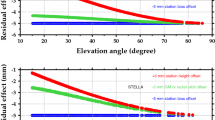Abstract
Current satellite missions dedicated to global mapping of the Earth’s gravity field are providing accurate global models of the geopotential. Harmonic (Stokes) coefficients of the geopotential derived from satellite observations of its functionals, a potential gradient vector and/or gravity gradient tensor, correspond to the (time-averaged) gravitational potential that is generated by the geoid, topography and atmosphere. The manuscript deals with the effect of static topographical and atmospheric masses on spaceborne observations of the potential gradient vector and gravity gradient tensor that should be applied during their inversion into the geopotential at the geoid level. They would allow for derivation of a harmonic representation of the potential generated only by solid masses inside the geoid and ocean, i.e., harmonicity of the geopotential would apply to the entire space outside the geoid. The geopotential could be then synthesized without problems with diverging harmonic series, i.e., the fundamental condition for application of a truncated harmonic series everywhere outside the geoid would be met. Due to its large numerical values, compensation of topographical masses is outlined using a single-layer potential. Although not entirely sufficient from a geophysical point of view, this model is often applied in geoid-related computations. Corresponding parameters are evaluated in manners that are consistent with spatial resolution and accuracy of current spaceborne data using spherical harmonic representation of topographical heights and corresponding mass distributions. Theoretical formulations are followed by numerical evaluations.
Similar content being viewed by others
References
Abramowitz M. and Stegun I.A., 1972. Handbook of Mathematical Functions with Formulas, Graphs, and Mathematical Tables. Dover, New York, USA.
Arfken G., 1985. Mathematical Methods for Physicists. Academic Press, Orlando, USA.
Chao B.F. and Au A.Y., 1991. Temporal variation of Earth’s zonal gravitational field caused by atmospheric mass redistribution: 1980–1988. J. Geophys. Res., 96, 6569–6575.
Edwards M.H. and Arvidson R.E., 1985. Report MGG-2. In: J.R. Heirtzler (Ed.), Relief of the Surface of the Earth., World Data Center A, National Geophysical Data Center, Boulder, USA.
Grafarend E.W. and Engels J., 1993. The gravitational field of topographic-isostatic masses and the hypothesis of mass condensation. Surv. Geophys., 140, 495–524.
Heck B., 2003. On Helmert’s method of condensation. J. Geodesy, 77, 155–170.
Heck B. and Wild F., 2004. Topographic-isostatic reductions in satellite gravity gradiometry based on a generalized condensation model. In: F. Sansó (Ed.), Proccedings of the IAG General Assembly, Sapporo 2003. Springer-Verlag, Heidelberg, Berlin, New York.
Heiskanen W.A. and Moritz H., 1967. Physical Geodesy. Freeman and Co., San Francisco, USA.
Huang J., Vaníček P., Brink W. and Pagiatakis S., 2001. Effect of topographical mass density variation on gravity and the geoid in the Canadian Rocky Mountains. J. Geodesy, 74, 805–815.
Lemoine F.G., Kenyon S.C., Factor J.K., Trimmer R.G., Pavlis N.K., Chinn D.S., Cox C.M., Klosko S.M., Luthcke S.B., Torrence M.H., Wang Y.M., Williamson R.G., Pavlis E.C., Rapp R.H. and Olson T.R., 1998. The Development of the Joint NASE GSFC and the National Imagery and Mapping Agency (NIMA) Geopotential Model EGM96. National Aeronautics and Space Administration, Goddard Space Flight Center, Greenbelt, Maryland, USA.
Martinec Z., 1998. Boundary-value problems for gravimetric determination of a precise geoid. Lecture Notes in Earth Sciences. Springer-Verlag, Heidelberg, Berlin, New York.
Martinec Z. and Vaníček P., 1994. The indirect effect of topography in the Stokes-Helmert technique for a spherical approximation of the geoid. Manuscripta Geodaetica, 19, 213–219.
Novák P., 2000. Evaluation of Gravity Data for the Stokes-Helmert Solution to the Geodetic Boundary-Value Problem. Technical Report 207, Department of Geodesy and Geomatics Engineering, University of New Brunswick, Fredericton, Canada.
Rummel R., Rapp R.H., Sünkel H. and Tscherning C.C., 1988. Comparisons of Global Topographic/Isostatic Models to the Earth’s Gravity Field. Report 388, Department of Geodetic Science and Surveying, The Ohio State University, Columbus, USA.
Sünkel H., 1986. Global topographic-isostatic models. In: Mathematical and numerical techniques in physical geodesy. Lecture Notes in Earth Sciences. Springer-Verlag, Heidelberg, Berlin, New York.
Swenson S. and Wahr J., 2002. Estimated effects of the vertical structure of atmospheric mass on the time-variable geoid. J. Geophys. Res., 107(B9), Art. No. 2194.
Tsoulis D., 2001. A comparison between the Airy/Heiskanen and the Pratt/Hayford isostatic models for the computation of potential harmonic coefficients. J. Geodesy, 74, 637–643.
Vaníček P., Najafi M., Martinec Z., Harrie L. and Sjöberg L.E., 1995. Higher-degree reference field in the generalized Stokes-Helmert’s scheme for geoid computation. J. Geodesy, 70, 176–182.
Wichiencharoen C., 1982. The indirect effects on the computation of geoid undulations. Report No. 336, Ohio State University, Columbus, USA.
Xu Y.L., 1996. Fast evaluation of the Gaunt coefficients. Math. Comput., 65, 1601–1612.
Author information
Authors and Affiliations
Corresponding author
Rights and permissions
About this article
Cite this article
Novák, P., Grafarend, E.W. The effect of topographical and atmospheric masses on spaceborne gravimetric and gradiometric data. Stud Geophys Geod 50, 549–582 (2006). https://doi.org/10.1007/s11200-006-0035-7
Received:
Revised:
Accepted:
Published:
Issue Date:
DOI: https://doi.org/10.1007/s11200-006-0035-7




